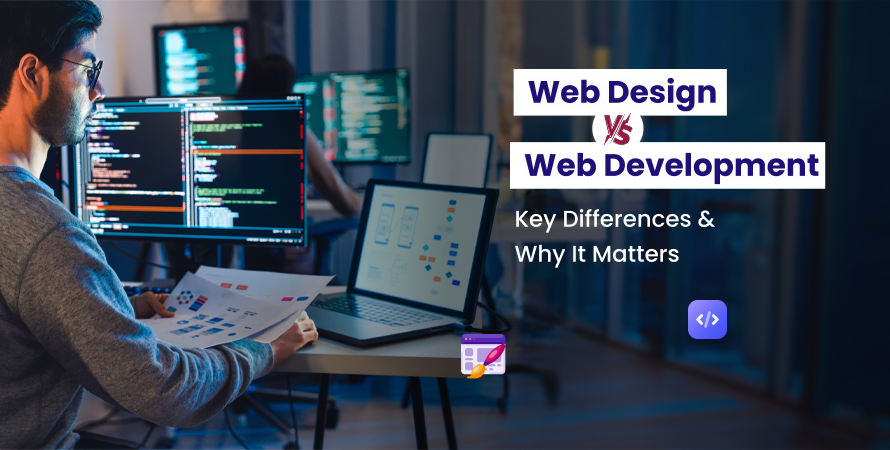Web Design vs Web Development: Key Differences & Why It Matters



Introduction
In today’s digital-first world, your website is often the first impression potential customers will have of your business. A well-crafted site can build credibility, drive engagement, and increase conversions. But to create a high-performing website, it’s essential to understand two key disciplines: web design and web development.
Though closely related, these terms refer to entirely different aspects of building a website. Yet many business owners, marketing managers, and even startups confuse them or use them interchangeably. Knowing the distinction isn’t just a matter of semantics — it’s crucial to ensuring that your digital project is successful.
Whether you’re hiring a digital marketing agency or assembling an in-house team, grasping the roles and responsibilities in web design and development can significantly influence the quality, cost, and performance of your online presence.
This guide will clarify what website design and development entail, how they differ, why the distinction matters, and how to choose the right web design and development services for your business.
What is Web Design?
Web design refers to the visual aesthetics and user experience of a website. It focuses on layout, color schemes, typography, imagery, and the overall look and feel of the site. But modern web design is more than just making things look good — it’s about creating an intuitive, engaging, and accessible experience for users.
Key Elements of Web Design
- Layout and Structure
A web designer decides where elements like headers, images, and call-to-action buttons go. They organize the content in a visually pleasing and user-friendly manner. - Color Scheme and Typography
Choices around colors and fonts are crucial for brand identity and readability. Designers often use principles of color theory to evoke specific emotions. - User Interface (UI) and User Experience (UX)
Designers create wireframes and mockups that define the flow of the site. Good UI and UX design guide users effortlessly through your site. - Responsiveness and Accessibility
A good web designer ensures your site is accessible to all users and works across all devices, including mobile, tablets, and desktops. - Branding and Visual Identity
Designers make sure that the site visually represents your brand and communicates your message effectively.
Tools Used by Web Designers
These tools help designers create prototypes and visual mockups before development begins.
What is Web Development?
Web development is the process of turning web designs into functional websites using programming languages, frameworks, and tools. Developers bring the visual elements to life by building the structure, writing the code, and enabling user interactions.
Website development is typically divided into two main categories:
Frontend Development
This involves coding everything the user interacts with — layout, buttons, navigation, animations. Frontend developers use:
- HTML (HyperText Markup Language)
Structures the content. - CSS (Cascading Style Sheets
Styles the visual layout. - JavaScript
Adds interactive features like forms, sliders, and pop-ups.
Frameworks like React, Vue, and Angular help create more dynamic, responsive experiences.
Backend Development
Backend development focuses on the server-side operations — databases, APIs, and logic that power your website behind the scenes.
Technologies often used include:
- Programming languages: PHP, Python, Node.js, Ruby
- Databases: MySQL, MongoDB, PostgreSQL
- Server frameworks: Laravel, Express, Django
Backend developers ensure that your site functions correctly, securely, and efficiently.
Web Design vs Web Development: A Side-by-Side Comparison
| Category | Web Design | Web Development |
|---|---|---|
| Focus | Visual aesthetics and user experience | Functionality, performance, and coding |
| Tools | Figma, Adobe XD, Sketch | HTML, CSS, JavaScript, PHP, frameworks |
| Core Skills | Creativity, layout planning, branding | Programming, logic, problem-solving |
| Output | Wireframes, mockups, visual design systems | Functional, interactive websites and web apps |
| Key Objective | Engaging, user-friendly visual interface | Stable, responsive, and feature-rich platform |
Why the Difference Matters
Failing to distinguish between web design and web development can lead to poor communication, unrealistic expectations, and even failed projects. Here’s why understanding the difference is so crucial:
1. Strategic Planning
Knowing the roles and responsibilities helps you define project timelines, deliverables, and milestones. You can better assign tasks and track progress.
2. Cost and Budget Allocation
Design and development require different tools, expertise, and timelines. Understanding this helps you allocate your budget more effectively.
3. Better Communication with Agencies
If you’re working with a digital marketing agency, clear understanding allows for more efficient discussions about your needs and goals. You can better evaluate their expertise in offering both web design and development services.
4. Improved User Experience
A strong collaboration between designers and developers ensures that your website is both visually appealing and functionally robust. One without the other often results in missed opportunities or frustrated users.
How Web Design & Development Support Digital Marketing Goals
Your website isn’t just a digital brochure — it’s the core of your marketing strategy. Seamless web design and development work together to support broader digital goals, including:
SEO (Search Engine Optimization)
- Design elements like mobile-friendliness, clear navigation, and fast-loading pages directly impact search rankings.
- Development practices such as clean code, schema markup, and fast servers also play a significant role.
Conversion Rate Optimization (CRO)
Good design leads users through a carefully crafted journey, while robust development ensures features like contact forms, eCommerce carts, and booking systems work smoothly.
Core Web Vitals
Core Web Vitals measure key aspects of site performance, such as load speed, interactivity, and visual stability. These are directly impacted by both frontend design choices and backend code efficiency.
Branding and Messaging
Your site reflects your brand voice and personality. Good design communicates this visually, and good development ensures it works correctly across all devices and browsers.
How to Choose the Right Web Design and Development Services
Finding the right partner for your website project is a major decision. Here are key things to consider:
1. Review Their Portfolio
Look at past projects to assess their design sensibility and technical proficiency. Do they create sites that are both beautiful and functional?
2. Ask About Their Process
Understand how they approach the design-to-development workflow. A good team has clear handoff points and collaboration processes in place.
3. Check for Integrated Services
Web design and development companies can provide a more unified experience. They understand how to balance aesthetics with technical requirements.
4. Look for Industry Experience
Whether it’s eCommerce, SaaS, or local services, domain experience can significantly impact the effectiveness of your site.
5. Evaluate Their Communication
Are they transparent? Do they explain technical concepts clearly? Effective communication is often a sign of professional expertise.
Common Myths & Misconceptions
“Designers Can Handle All the Development”
While some designers have coding skills, expecting them to build complex functionalities is unrealistic. It’s better to have specialists in both areas.
“Developers Don’t Care About Design”
The best developers understand design principles and care deeply about user experience. They often work closely with designers to achieve shared goals.
“Any Agency Can Do Both Equally Well”
Not all agencies excel in both design and development. Look for ones that demonstrate strength in both areas — not just one.
Future of Web Design and Development
As digital technologies evolve, the line between design and development continues to blur, but both disciplines are becoming more specialized. Here’s what to expect:
AI and Automation
Designers now use AI tools to speed up wireframing and user testing. Developers use automation for testing, deployments, and performance optimization.
Headless CMS
Decoupling the frontend from the backend allows for more flexibility, faster performance, and personalized experiences.
Progressive Web Apps (PWAs)
PWAs combine the best of web and mobile apps — and require seamless collaboration between design and development teams.
Voice-First and Responsive Design
Designers must now think about voice interfaces and micro-interactions, while developers integrate APIs and voice recognition tools
Conclusion
Understanding the difference between web design and web development is more than just a technicality — it’s foundational to building a successful online presence. Each discipline brings unique value to the table, and together, they create websites that are not only visually stunning but also functionally robust.
If you’re launching a new website or planning a redesign, it’s important to choose the right partner who understands the synergy between design and development. A cohesive approach ensures a smooth workflow, better performance, and a more enjoyable user experience.
Looking to build a site that excels in both form and function? Hire Core Web Vitals for expert web design and development services tailored to your business goals.
Frequently Asked Questions (FAQs)
Yes, some professionals are skilled in both design and development — often referred to as “full-stack” or “hybrid” developers. However, deep expertise in both areas is rare and usually not a substitute for a well-rounded team.
Neither is more important; both are essential. Design ensures users are engaged and guided visually, while development ensures the site performs well and functions as intended.
Budgets vary depending on complexity. A basic website may cost a few thousand dollars, while custom, feature-rich sites can range into the tens of thousands. It’s best to consult with a digital marketing agency to get a tailored estimate.
Look for an agency with experience, a strong portfolio, clear communication, and the ability to deliver both design and development seamlessly.
If your site is outdated visually, a redesign may be enough. But if performance, security, or responsiveness are lacking, a full rebuild by a team offering integrated web design and development services may be necessary.